 As some of you may know I contracted Leptospirosis in May 2014 and although I didn’t really want to write this article and elicit sympathy from anyone and have avoided writing it for a few years, I felt that now was the time especially with the increase in vessels being converted into houseboats.
As some of you may know I contracted Leptospirosis in May 2014 and although I didn’t really want to write this article and elicit sympathy from anyone and have avoided writing it for a few years, I felt that now was the time especially with the increase in vessels being converted into houseboats.
I was called to a vessel that was apparently sinking in the River Medway.
Upon arrival at the vessel it was clear that the vessel was in fact afloat still but had a large volume of water in the after cabins. My first response was to ascertain whether the water was indeed from an external source i.e river water or from an internal source i.e. a fresh water leak.
As I had done many times previously I conducted simple taste test and quickly ascertained that it was in fact “fresh” water. I then examined the vessel’s water system and found that all piping was still well installed and properly connected and that the water tank was in good order with no sign of leaks, a mystery indeed.
I advised the owner to pump out the water and to keep the area under observation and to call me if any further water were to appear. After six or seven days I had heard nothing.
During the next couple of days, I had been doing some work in the garden at home and started to feel unwell but initially I put that down to having overdone it. Over the next few hours I started to feel weak and developed a serious headache, at this point I rang the doctor and made an appointment. Initially the doctor intimated that it may be meningitis but that as I had no rash or sensitivity to light was quickly dismissed. The advice was to go home, drink lots of water and take paracetamol and to return in a few days if the symptom persisted.
Unusually for me I followed the doctor’s orders but the weakness and headache became progressively worse and I developed uncontrollable shivering and so a visit to the Accident and Emergency department ensued upon which it was decided that I had contracted hepatitis A and should go home, drink lots of water and take paracetamol.
That night my wife became increasingly concerned as I had developed a fever so a further visit to hospital was undertaken. Upon arrival, it was clear to the doctors that something was seriously wrong and I was admitted immediately and placed on a saline drip.
The next few hours are a bit of a blur but a huge number of blood tests, CT scans and ultrasounds were carried out and initially nothing was diagnosed although the blood tests showed that my liver had extremely elevated readings.
I was given numerous antibiotics and liquid paracetamol over a 24 hour period but the 41 degree fever would not subside, to the point that it was clear that my life was at risk.
A series of different medications were administered to me and, after eight days in hospital, I had recovered sufficiently to return home although at that point nothing had been officially diagnosed and the only possible suggestion to fit the symptoms was leptospirosis despite not showing up in blood tests.
After a further three weeks convalescing, I was able to return to work and some investigation into what may have caused the illness was undertaken.
As it turned out, the vessel in question had been converted to a houseboat some twenty years previously and the bilges were cleaned out but, instead of disposing of the contents properly, the liquid and debris were placed into one of her ballast tanks. The tank had subsequently corroded from the inside and had deposited its contents into the aft cabin ready for an unsuspecting surveyor to taste it. Obviously, the true contents of the water are unknown but I can assure you that I no longer undertake taste tests on water and advise that no one else does the same.
In order to prevent anyone suffering the same as I did, I thought it prudent to highlight the dangers faced when working in or around water.
Introduction to Leptospirosis
Leptospirosis is a bacterial infection caused by certain members of the genus leptospira.
 Most people who develop a leptospirosis infection only get mild symptoms but a bit more serious influenza- like symptoms are also quite common. In a minority of infected persons, leptospirosis develops into the dreaded Weill’s disease. Weill’s disease is a serious condition that can involve liver failure, kidney failure, meningitis and sepsis. Weill’s disease can be fatal.
Most people who develop a leptospirosis infection only get mild symptoms but a bit more serious influenza- like symptoms are also quite common. In a minority of infected persons, leptospirosis develops into the dreaded Weill’s disease. Weill’s disease is a serious condition that can involve liver failure, kidney failure, meningitis and sepsis. Weill’s disease can be fatal.
Weill’s disease is caused by leptospira interrogans belonging to the serogroup Icterohaemorrhagiae or Pomona. A person who develops Weill’s disease will usually have gone through influenza like symptoms of leptospirosis for a week or so and seemingly be well on their way to recovery. After a short period of no symptoms or only mild symptoms, the person gets very ill with symptoms of poor liver function, poor kidney functions, meningitis and/or sepsis. The lethality for Weill’s disease is 5% – 10%.
Transmission
Urine and blood from a leptospirosis infected person or animal can contain a sufficient amount of bacteria to spread the disease. A common transmission route for humans is getting urine or blood from an infected animal on damaged skin. Even a tiny skin abrasion can be enough for the bacteria to get into the body. Leptospira bacteria can also enter the body through mucous membranes, e.g. those found in the eyes, nose, mouth and genitals.
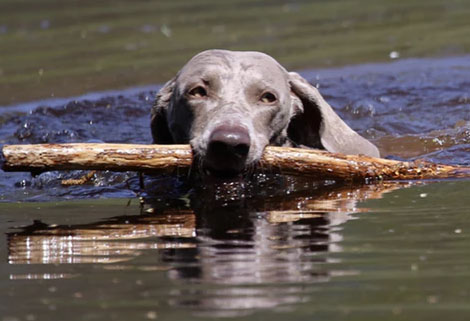 When infected blood or urine gets into water or soil, the bacteria can survive there for several months.
When infected blood or urine gets into water or soil, the bacteria can survive there for several months.
Many different animals can carry and transmit leptospirosis, including dogs, rodents, cattle, horses and pigs. An infected animal is often symptom free and can continue to excrete bacteria into the environment year after year.
The incubation time for leptospirosis in humans is usually one to two weeks but anywhere from 48 hours to more than a month has been reported.
Symptoms
Examples of symptoms from the eyes
- Eye inflammation can occur, with reddening of the eyes and increased sensitivity to light.
- If leptospirosis bacteria causes liver inflammation with poor liver function as a result, one noticeable symptom can be the yellowing of the sclera. The sclera is the white part of the eye; the part that surrounds the iris. When the liver isn’t working properly, the sclera becomes yellow due to increased levels of bilirubin in the body. In some cases, the sclera can even look greenish. Always check your eyes before you put in your contact lenses if you wear colored lenses. If you do not you risk not seeing the symptoms of leptospirosis, liver damage and a long row of different diseases.
Examples of symptoms from the skin
- Skin rash
- If leptospirosis bacteria causes liver inflammation with poor liver function as a result, symptoms can include the yellowing of the skin due to increased levels of bilirubin. In such situations, itchy skin is also common. In severe cases, the skin can look greenish rather than yellowish.
Examples of symptoms from the digestive system
- Stomach ache
- Diarrhea
- Vomiting
- If leptospirosis bacteria causes liver inflammation with poor liver function as a result, symptoms can include pale faeces and dark urine.
Examples of symptoms from the respiratory system
- Coughing up blood (caused by lung bleeding)
Examples of other symptoms
- High fever
- Chills
- Headache
- Muscle ache
Edema Treatment
Leptospira bacteria are sensitive to several different antibiotics, including well-known ones such as Penicillin and Doxycycline.
If the infection is diagnosed early and symptoms are mild, oral antibiotics are often sufficient. In more severe cases, intravenous treatment with antibiotics may be necessary. Each individual symptom can also require specific treatment. If kidney function is impaired, dialysis can be carried out.
When an MD has good reason to suspect leptospirosis in a patient, antibiotic treatment is typically started right away, without waiting for test results.
How quickly can an illness develop?
Human leptospirosis takes a while to incubate, and the normal range between exposure and illness is 3 to 14 days, although it can take up to 21 days. It’s considered extremely unlikely that the illness would show earlier than 24 hours after exposure, even if the patient was otherwise unwell. In rare cases the incubation time can be very long (several weeks) but we normally assume that if there is no illness after 30 days then infection is either not present, or was subclinical.
Illness that develops within 12 hours of the exposure event would not be leptospiral in origin. Often infections that involve contaminated water can show illness very rapidly, caused by the effects of other unrelated bacteria and viruses in the water (such as E.coli or cryptosporidium) or from some chemicals, and while these would not in themselves normally be life-threatening, they can mask the later symptoms of leptospirosis.
The incubation time depends on the strain of bacteria involved, as some strains reproduce faster in human blood than others, but the main factor is the size of the ‘inoculum’ – the dose of bacteria that entered the patient during their exposure. Although it’s perfectly possible to be infected from a single bacterium, in reality the illness develops because the rate that the bacteria are reproducing is faster than the patient’s immune system can control. Bacteria grow by splitting in half, so one becomes two, two become four, and so on. If the patient received a large number of bacteria from the initial contact then the numbers in their bloodstream will be larger, and increase faster – hence the illness develops sooner.
It’s very difficult to predict the incubation time in a patient, but in very general terms the concentration of bacteria in the inoculum will be important (water from a large clean river will have many times less bacteria per litre than urine direct from a rat) and the volume that enters the body (infection via small cuts to the skin usually involve very small volumes of liquid, but swallowing water after a fall into a lake will of course involve far more. The balance of course is that the situations where patients suffer a high-volume intake are usually those where the liquid has a low concentration (you are unlikely to fall into a tank of rat urine).
Precautions against infection
To minimise the chances of infection, the only truly effective way is to avoid contact with contaminated water and animals, thus avoiding exposure to the bacterium. If you are in a high risk area, you should always attempt to minimise contact, as there are many hundreds of other organisms that can lurk in the water apart from Leptospira. Unless you are required to enter the water, you should stay away from it. Animals themselves present a risk while infected, as their body fluids can contain the bacteria.
Water
The vast majority of human cases are from contaminated water, and of those the majority are occupational cases from areas of the world where agriculture and rodents mix – rice-farming, cane-growing and so forth. Recreational exposure is next, with cases amongst swimmers being the obvious top grouping. Lowest of the risk groups is occupational exposure in the developed world – water and sewer engineers, construction, pest control and so on.
Clearly there are problems in preventing exposure in the highest risk activities (rice-farming and such) and in those areas the only option is to be aware of symptoms and seek early treatment. At this time there is no universally-agreed human vaccine, and the preventative use of antibiotics can only be considered for short periods.
Swimming is the greatest risk, and several cases are reported each year from swimming in contaminated water (both in the developed world and in activities such as adventure racing). There is no practical way to prevent exposure as some water will always enter the mouth. For one-off activities such as expeditions there is an argument for using a preventative antibiotic (doxycycline) which can offer increased resistance to illness for a few weeks. It should never be used long-term.
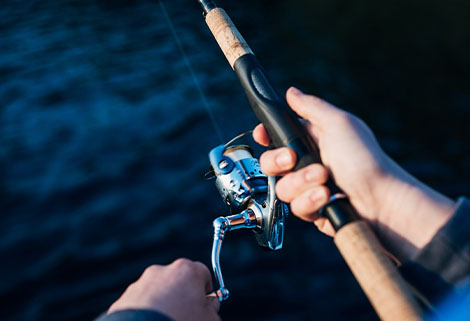 Anglers and bankside/sewer workers should wear splashproof clothing and expecially gloves. Anglers are at higher risk as it is reasonably common to cause minor cuts with hooks, knives and the like, and this greatly increases the ease by which the bacteria can enter the body. Fish caught from suspect areas should of course never be eaten. Whilst cooking does in theory kill any bacteria within a fish, very often the level of cooking is insufficient to guarantee safety.
Anglers and bankside/sewer workers should wear splashproof clothing and expecially gloves. Anglers are at higher risk as it is reasonably common to cause minor cuts with hooks, knives and the like, and this greatly increases the ease by which the bacteria can enter the body. Fish caught from suspect areas should of course never be eaten. Whilst cooking does in theory kill any bacteria within a fish, very often the level of cooking is insufficient to guarantee safety.
Recreational exposure (swimming, skiing, sailing, caving, etc) is clearly done at the person’s own risk and they must weigh up their own balance of risk vs. desire. The same preventative measures apply – minimise the risk of water entering the body by any and all means, consider antibiotics if the risks are very high, and be aware of the symptoms and seek treatment immediately. There are no ‘quick fixes’ to prevent infection. Some swimmers wash their mouths with antibacterial rinse, though this has not been proved to offer any significant benefit other than keeping their teeth clean.
Scuba divers, who are particularly at risk, should opt for drysuits and try as much as possible to avoid swallowing any water when purging or changing regs. Commercial divers are required by their employment regulations and insurance to comply with strict rules when working in contaminated water, these include the use of hard-hat systems, wash-down stations and regular medical testing.
Remember that this advice applies to FRESH water – the risks in saltwater are virtually zero.


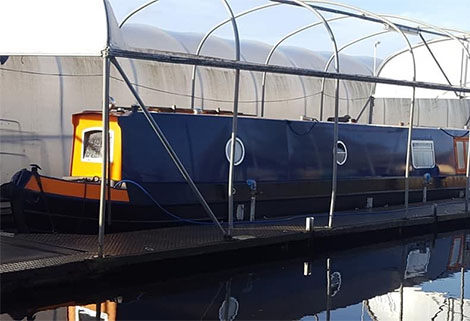
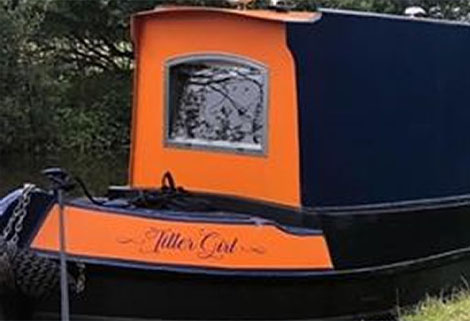 Tiller Girl was built as a 2 berth live aboard in 2014 and I felt she would perfectly fit the bill of my idea to have a couples' retreat, a luxury boat for time out and relaxation as well as family holidays.
Tiller Girl was built as a 2 berth live aboard in 2014 and I felt she would perfectly fit the bill of my idea to have a couples' retreat, a luxury boat for time out and relaxation as well as family holidays.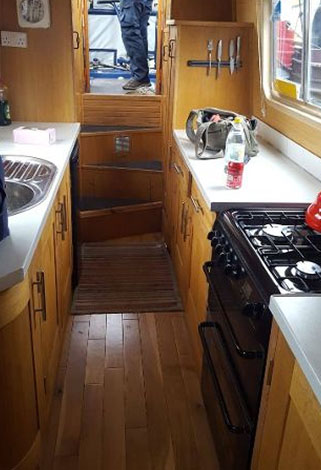 And then we started on making the interior into what I felt would be expected of a luxury hire boat.
And then we started on making the interior into what I felt would be expected of a luxury hire boat.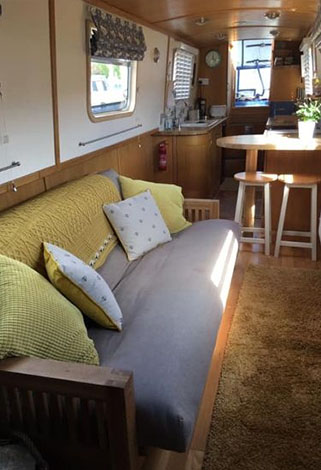 Julie Cutts, the manager at Sawley Marina where we decided to moor her, was an absolute gem as are all the staff (and many of the boat neighbours) and have supported me all the way with great wealth of knowledge of hire boat companies, to mooring and giving us our own embarkation point at the marina and for all of this I pay a commercial mooring fee which is an extra 30%.
Julie Cutts, the manager at Sawley Marina where we decided to moor her, was an absolute gem as are all the staff (and many of the boat neighbours) and have supported me all the way with great wealth of knowledge of hire boat companies, to mooring and giving us our own embarkation point at the marina and for all of this I pay a commercial mooring fee which is an extra 30%.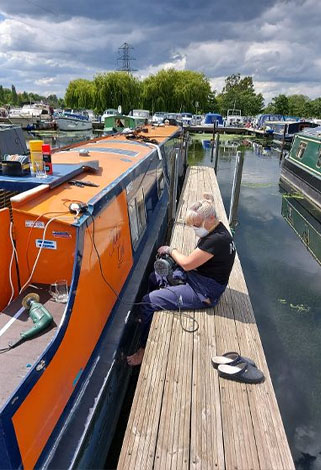 Then COVID-19 reared it's nasty viral head and everything came to a sudden stop! I fully refunded everyone who had made a booking and by this time, funds were running low. I couldn't carry out the planned external painting and the Marina was flooded. So a worrying time all round.
Then COVID-19 reared it's nasty viral head and everything came to a sudden stop! I fully refunded everyone who had made a booking and by this time, funds were running low. I couldn't carry out the planned external painting and the Marina was flooded. So a worrying time all round.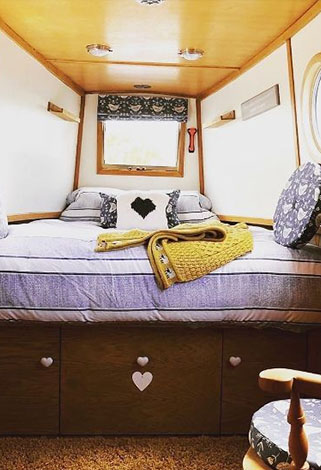
 Hand over is intensive and takes around 2 hours, with a tour of the internal features including fire safety, exits and cassette toilet. I encourage all hirers to read the manual and watch the videos on the website prior to coming on Tiller Girl and ask them to sign an agreement that holds them responsible for the boat.
Hand over is intensive and takes around 2 hours, with a tour of the internal features including fire safety, exits and cassette toilet. I encourage all hirers to read the manual and watch the videos on the website prior to coming on Tiller Girl and ask them to sign an agreement that holds them responsible for the boat.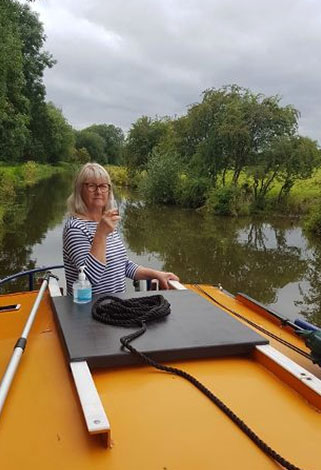
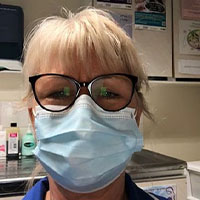 Melanie Franklin-Pryce is the owner of Luxury Narrowboat Hire 'Tiller Girl'.
Melanie Franklin-Pryce is the owner of Luxury Narrowboat Hire 'Tiller Girl'. Long ago I met my future wife after mooring up next to her. We spent the next few years being young ‘love-aboards’ and enjoying Narrowboat life.
Long ago I met my future wife after mooring up next to her. We spent the next few years being young ‘love-aboards’ and enjoying Narrowboat life.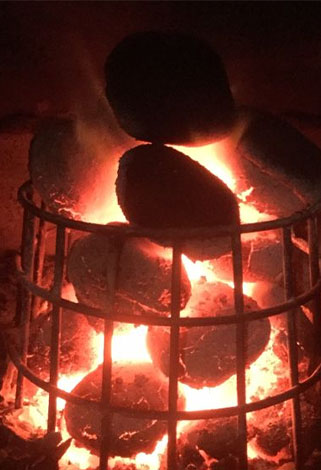 It suddenly dawned on me that if it had a basket of some sorts I could just bung it all in and it would take the faff and balancing act out of the procedure.
It suddenly dawned on me that if it had a basket of some sorts I could just bung it all in and it would take the faff and balancing act out of the procedure. Surely, I asked myself, there must be something available already? No - nothing. Nothing at all like it was available as a stove accessory for coal.
Surely, I asked myself, there must be something available already? No - nothing. Nothing at all like it was available as a stove accessory for coal. All the while this process was going on it was the hardest thing to keep quiet! We we’re so excited with how it was working and improving our stove experience. Visitors to the boat were kept at a minimum whilst we tried surreptitiously to draw any attention away from our stove. We now couldn’t imagine life without it!
All the while this process was going on it was the hardest thing to keep quiet! We we’re so excited with how it was working and improving our stove experience. Visitors to the boat were kept at a minimum whilst we tried surreptitiously to draw any attention away from our stove. We now couldn’t imagine life without it!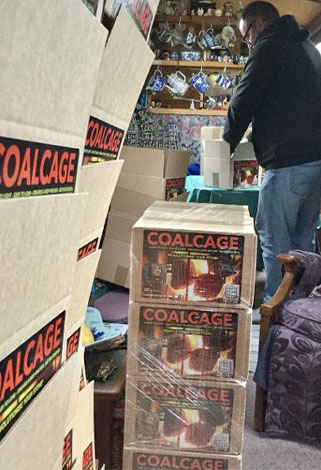 Getting the first batch was so exciting as it suddenly became real. Boxes and labels agreed with a local printer and we were away.
Getting the first batch was so exciting as it suddenly became real. Boxes and labels agreed with a local printer and we were away. Rosie & Wayne Sharman live aboard their narrowboat James Arthur and if you are lucky enough to spot them on the cut, you can buy directly from their boat.
Rosie & Wayne Sharman live aboard their narrowboat James Arthur and if you are lucky enough to spot them on the cut, you can buy directly from their boat. The Oxbow Excel briquettes are produced at our plant in County Durham in the North East of England.
The Oxbow Excel briquettes are produced at our plant in County Durham in the North East of England.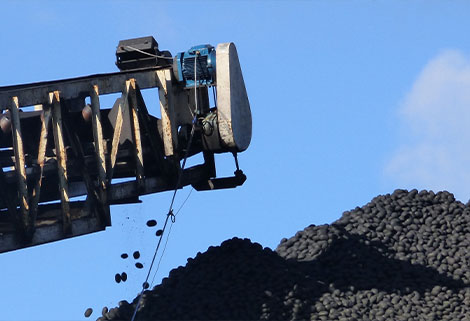 Since then Oxbow have learned not to mess with the classics and the Oxbow Excel remains consistently top quality with the recipe largely unchanged for many years.
Since then Oxbow have learned not to mess with the classics and the Oxbow Excel remains consistently top quality with the recipe largely unchanged for many years.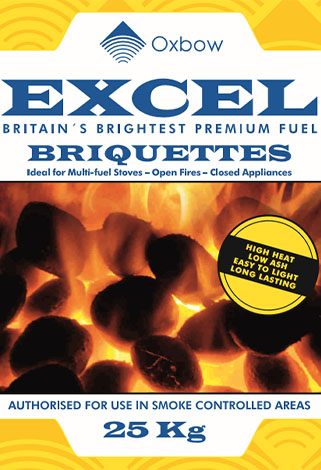 Instead of bringing out a new fuel to compliment the open fire fuel Oxbow Excel was considered to be, Oxbow, with minor adjustments, made the fuel versatile enough in its own right to be considered a multi-purpose fuel.
Instead of bringing out a new fuel to compliment the open fire fuel Oxbow Excel was considered to be, Oxbow, with minor adjustments, made the fuel versatile enough in its own right to be considered a multi-purpose fuel. Oxbow Coal Ltd provides a diverse line of products, backed by expert technical support and knowledgeable customer service. Our philosophy is that the most effective way to earn a customer’s trust and loyalty is through the superior performance of our products as well as the energy and talent of our people.
Oxbow Coal Ltd provides a diverse line of products, backed by expert technical support and knowledgeable customer service. Our philosophy is that the most effective way to earn a customer’s trust and loyalty is through the superior performance of our products as well as the energy and talent of our people.


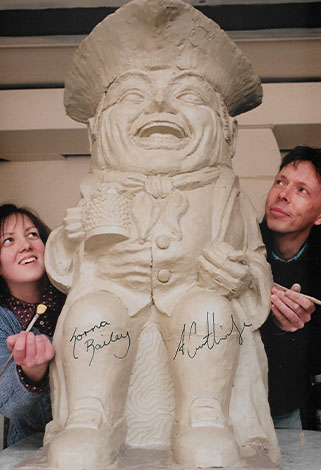 Standing over three feet tall, this Toby Jug was commissioned by the American Toby Jug Museum, based near to Chicago in the USA.
Standing over three feet tall, this Toby Jug was commissioned by the American Toby Jug Museum, based near to Chicago in the USA.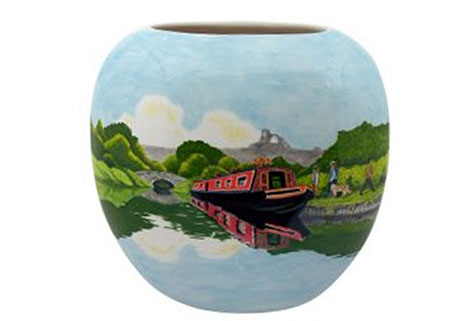 More recently, Tony has been hand painting vases with his own designs for Stoke Art Pottery, each design being totally exclusive.
More recently, Tony has been hand painting vases with his own designs for Stoke Art Pottery, each design being totally exclusive.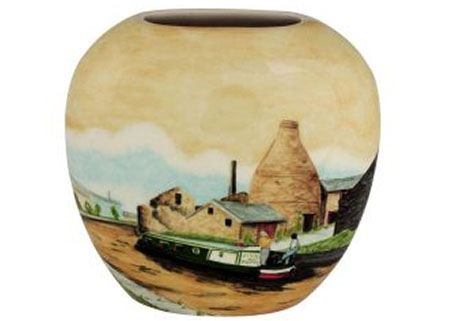 The idea was hatched - so after some heart searching it was decided we should go ahead and offer the facility of hand painting owners own canal boats onto the scenes already developed.
The idea was hatched - so after some heart searching it was decided we should go ahead and offer the facility of hand painting owners own canal boats onto the scenes already developed.
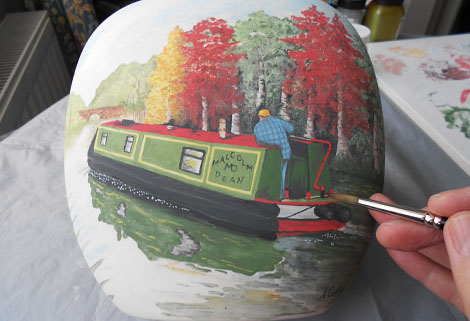
 The hand drawing and hand painting of each vase will take three to four days to complete. The delivery time for each order is 28 days, and as already stated, each will come with its own certificate of authentication.
The hand drawing and hand painting of each vase will take three to four days to complete. The delivery time for each order is 28 days, and as already stated, each will come with its own certificate of authentication.
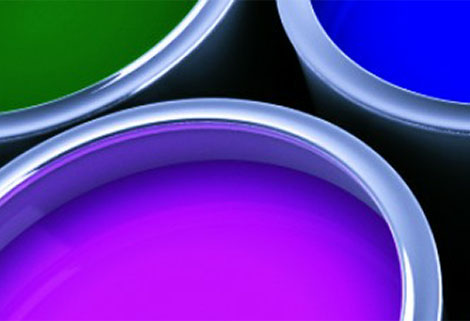 Weather conditions play an important part when painting outside. Avoid if possible painting in direct sunlight or when the boat is obviously warm to the touch. The ideal temperature for painting is between 12oC and 20oC. Higher temperatures could result in poor flow, rapid drying and loss of gloss. Windy conditions will lead to dirt pick-up and faster drying. Do not apply in damp conditions and aim at finishing painting by mid-afternoon, as overnight condensation may affect the finish.
Weather conditions play an important part when painting outside. Avoid if possible painting in direct sunlight or when the boat is obviously warm to the touch. The ideal temperature for painting is between 12oC and 20oC. Higher temperatures could result in poor flow, rapid drying and loss of gloss. Windy conditions will lead to dirt pick-up and faster drying. Do not apply in damp conditions and aim at finishing painting by mid-afternoon, as overnight condensation may affect the finish.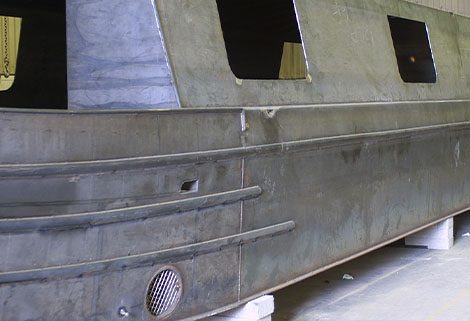 BARE STEEL
BARE STEEL  PREVIOUSLY PAINTED SURFACES
PREVIOUSLY PAINTED SURFACES 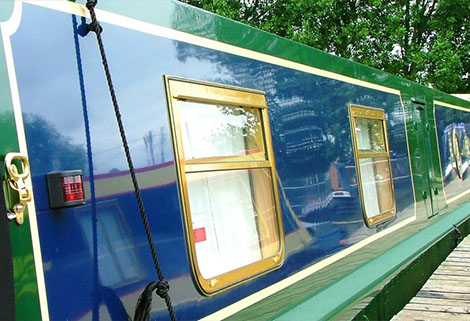 Apply the paint using a good quality 2½” to 3” brush. Gloss rollers and pads can also be used. To ensure even application, apply by crossing brush strokes before laying-off. On boat sides, always lay-off with vertical strokes. With large areas such as cabin tops, best results can be obtained by two people applying to prevent loss of wet edge – one person applying, the other laying-off. When brushing, it is recommended that the brush is held at 45 degrees to minimise brush marking. Where masking tape is being used, it is recommended that this is removed before the paint has reached a light touch-dry state, as this will ensure a smoother edge.
Apply the paint using a good quality 2½” to 3” brush. Gloss rollers and pads can also be used. To ensure even application, apply by crossing brush strokes before laying-off. On boat sides, always lay-off with vertical strokes. With large areas such as cabin tops, best results can be obtained by two people applying to prevent loss of wet edge – one person applying, the other laying-off. When brushing, it is recommended that the brush is held at 45 degrees to minimise brush marking. Where masking tape is being used, it is recommended that this is removed before the paint has reached a light touch-dry state, as this will ensure a smoother edge.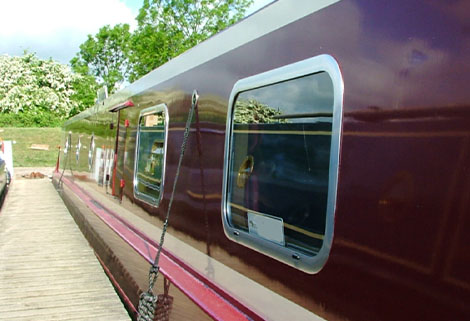 Wipe over thoroughly after abrading, as dust and debris will affect the final appearance. The smoothness of the finish is ultimately dependent on the preparation, especially for Undercoats and Primer/Filler. Where coarse profile steel has been used, or where underlying imperfections in the surface exist, extra coats of Primer/Filler and Undercoats should be used.
Wipe over thoroughly after abrading, as dust and debris will affect the final appearance. The smoothness of the finish is ultimately dependent on the preparation, especially for Undercoats and Primer/Filler. Where coarse profile steel has been used, or where underlying imperfections in the surface exist, extra coats of Primer/Filler and Undercoats should be used.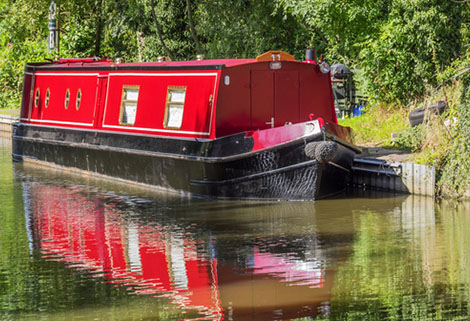 NEW WOOD
NEW WOOD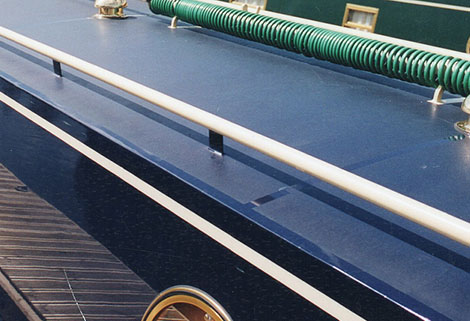 Rylard Slip Resistant additive can be used with all Rylard topcoats.
Rylard Slip Resistant additive can be used with all Rylard topcoats.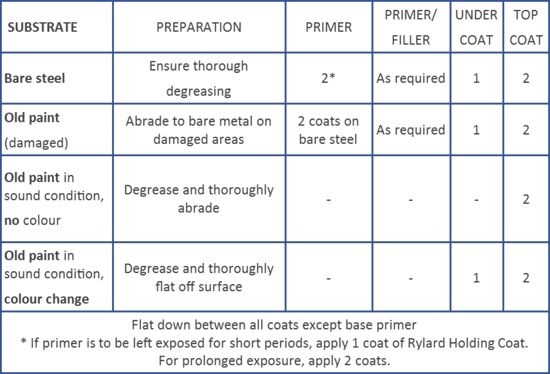

 Rylard Paints is a well-respected name in the supply of paints for canal boats, narrow boats, dutch barges and leisure craft. Through its Research and Development program Rylard continues to provide state-of-the-art products, manufactured in the UK to the highest Quality standards. We provide a range of coatings for canal boats, from blacking to topsides, anti-slip for decks and roofs, to brass lacquer to keep metal fitments glowing.
Rylard Paints is a well-respected name in the supply of paints for canal boats, narrow boats, dutch barges and leisure craft. Through its Research and Development program Rylard continues to provide state-of-the-art products, manufactured in the UK to the highest Quality standards. We provide a range of coatings for canal boats, from blacking to topsides, anti-slip for decks and roofs, to brass lacquer to keep metal fitments glowing.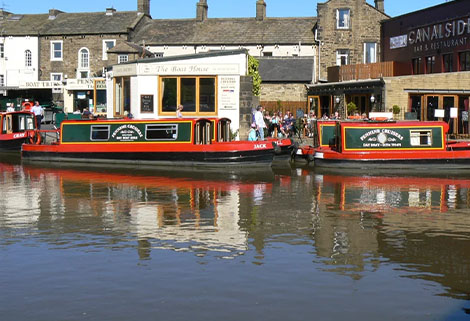 Through odd canal holidays, trips on the rivers and being fortunate enough to have friends on the canals as a child, I eventually caught up with our fantastic inland waterways and the lovely people that live, work and holiday on them. We found a fantastic company to hire from, Pennine Cruisers. A Skipton based company on that lovely Leeds and Liverpool canal. This company soon became the key to the start of Yorkshire Bespoke Tiller Pins. As the article goes on you will see why. All staff and owners, over many trips with them, soon became what me and my wife class as our Skipton family.
Through odd canal holidays, trips on the rivers and being fortunate enough to have friends on the canals as a child, I eventually caught up with our fantastic inland waterways and the lovely people that live, work and holiday on them. We found a fantastic company to hire from, Pennine Cruisers. A Skipton based company on that lovely Leeds and Liverpool canal. This company soon became the key to the start of Yorkshire Bespoke Tiller Pins. As the article goes on you will see why. All staff and owners, over many trips with them, soon became what me and my wife class as our Skipton family.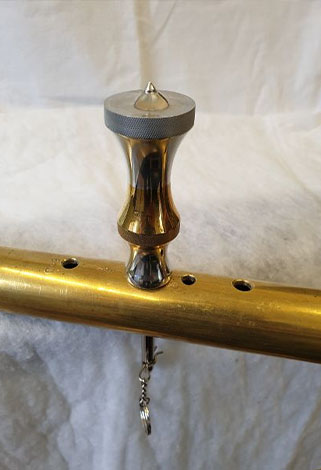 On rummaging around, I found an old piece of round brass stock, along with a solid piece of aluminium from my workshop stock. Straight away I knew I was going to make him a tiller pin. The two pieces of material had caught my eye, even though they were both very dull. I thought that if I could use the two pieces together, the result would be quite unique. I began looking at new ways on how to work and join the two pieces together. I also knew when they were machined, they had to give a flawless impression as though they were all from one piece. I eventually found a way to do this and set about making the blank into an attractive eye-catching shape. This just seemed to flow and sooner rather than later, the tiller pin was made. I was unsure if I was on the right track with it all, so for a bit of confirmation I sent a picture of it to ‘Our Zoe’ at Pennine Cruisers to ask her opinion. I was expecting some changes may be needed, but all I got from Zoe was ‘Wayne is going to love that!’ It was buffed, polished and ready for our trip up to Skipton for our next of now many boat trips.
On rummaging around, I found an old piece of round brass stock, along with a solid piece of aluminium from my workshop stock. Straight away I knew I was going to make him a tiller pin. The two pieces of material had caught my eye, even though they were both very dull. I thought that if I could use the two pieces together, the result would be quite unique. I began looking at new ways on how to work and join the two pieces together. I also knew when they were machined, they had to give a flawless impression as though they were all from one piece. I eventually found a way to do this and set about making the blank into an attractive eye-catching shape. This just seemed to flow and sooner rather than later, the tiller pin was made. I was unsure if I was on the right track with it all, so for a bit of confirmation I sent a picture of it to ‘Our Zoe’ at Pennine Cruisers to ask her opinion. I was expecting some changes may be needed, but all I got from Zoe was ‘Wayne is going to love that!’ It was buffed, polished and ready for our trip up to Skipton for our next of now many boat trips.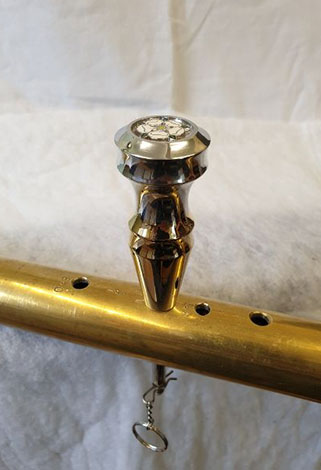 By our next visit 6 weeks later, now October 2019, I had come up with 4 new designs all combining brass and aluminium. However, one of these was clearly turning heads: Tiller Pin Zoe (all my pins are named after the staff at Pennine Cruisers). Tiller pin Zoe was a little different, because I had incorporated a recess in the top to house an enamel Yorkshire rose.
By our next visit 6 weeks later, now October 2019, I had come up with 4 new designs all combining brass and aluminium. However, one of these was clearly turning heads: Tiller Pin Zoe (all my pins are named after the staff at Pennine Cruisers). Tiller pin Zoe was a little different, because I had incorporated a recess in the top to house an enamel Yorkshire rose.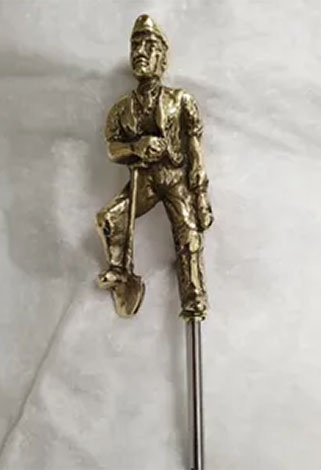 I started getting odd jobs - repairs, lathe work brazing and odd bits. Then people started sending me brass items that they wanted me to turn into tiller pins. Many were hollow and could not accommodate a good thread for the actual pin itself. So, I would machine a solid brass boss, then tig braze that to the hollow cast body. This was becoming a popular request, and other work started to flow in. Praise for my work was building and it was common for customers to say they were told that what I managed to do couldn’t be done. I suppose wrong advise from wrong person scenario.
I started getting odd jobs - repairs, lathe work brazing and odd bits. Then people started sending me brass items that they wanted me to turn into tiller pins. Many were hollow and could not accommodate a good thread for the actual pin itself. So, I would machine a solid brass boss, then tig braze that to the hollow cast body. This was becoming a popular request, and other work started to flow in. Praise for my work was building and it was common for customers to say they were told that what I managed to do couldn’t be done. I suppose wrong advise from wrong person scenario.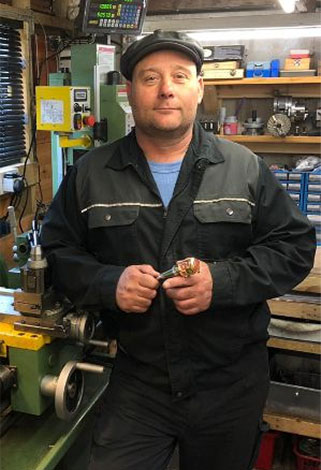 The rate and pace to me was exhausting. Sammie was relentless. Left no stone unturned. Within three days Yorkshire bespoke tiller pins had a running Facebook account. Had a web site not only built, but up and running. Had a PayPal account set up etc. Groups were getting in touch from our posts asking us to join. I had picked up my first big order thanks to Finesse boats who were very helpful and encouraging. This led to me finding a Sheffield based enamel logo and badge place. Which led to a local material suppliers Avus Metals. The snowball effect was starting to happen. New customers from the website and from Facebook were steadily on the up. Comments and positive feedback were a massive incentive for me to carry on. What really hit home was just how willing the much bigger companies, boat builders, marinas online canal merchants were to get behind the little firms. It really felt like big brothers were keeping a look out.
The rate and pace to me was exhausting. Sammie was relentless. Left no stone unturned. Within three days Yorkshire bespoke tiller pins had a running Facebook account. Had a web site not only built, but up and running. Had a PayPal account set up etc. Groups were getting in touch from our posts asking us to join. I had picked up my first big order thanks to Finesse boats who were very helpful and encouraging. This led to me finding a Sheffield based enamel logo and badge place. Which led to a local material suppliers Avus Metals. The snowball effect was starting to happen. New customers from the website and from Facebook were steadily on the up. Comments and positive feedback were a massive incentive for me to carry on. What really hit home was just how willing the much bigger companies, boat builders, marinas online canal merchants were to get behind the little firms. It really felt like big brothers were keeping a look out. It is very early days. I have a range of tiller pin bodies now and there will be more designs in the future. All named after Pennine Cruisers staff. There are now many other material options available and body material combinations. I am passionate about brass ware and love to repair figures that are broken – it gives them a second chance with a fantastic view from the tiller for their retirement. I find it very warming to know I have turned a personal object into a lovely tiller pin for someone. I now incorporate and work with more enamel options in my own tiller pin range along with boat name plates. I’m also venturing into other things for my growing customers, the cards are still on the table, but I believe they will be something to consider on your boat.
It is very early days. I have a range of tiller pin bodies now and there will be more designs in the future. All named after Pennine Cruisers staff. There are now many other material options available and body material combinations. I am passionate about brass ware and love to repair figures that are broken – it gives them a second chance with a fantastic view from the tiller for their retirement. I find it very warming to know I have turned a personal object into a lovely tiller pin for someone. I now incorporate and work with more enamel options in my own tiller pin range along with boat name plates. I’m also venturing into other things for my growing customers, the cards are still on the table, but I believe they will be something to consider on your boat.
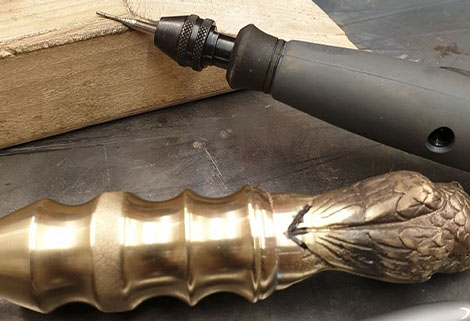
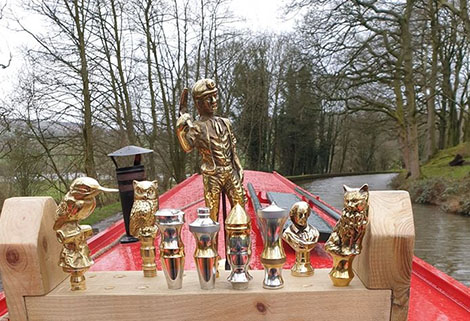
 Times have changed on the canal. The ‘old days’ are fading and a whole new community of canal dwellers and leisure boaters has arrived. This cannot be a bad thing, because it ensures that we still have canals to enjoy. With it has come a whole new generation of painters, many of whom have taken up painting roses and castles. A substantial number of these are producing attractive work, which is much admired but has drifted away, over the years, from the original.
Times have changed on the canal. The ‘old days’ are fading and a whole new community of canal dwellers and leisure boaters has arrived. This cannot be a bad thing, because it ensures that we still have canals to enjoy. With it has come a whole new generation of painters, many of whom have taken up painting roses and castles. A substantial number of these are producing attractive work, which is much admired but has drifted away, over the years, from the original. Nowadays the painting has, quite understandably, spread to all manner of items which can be acquired, painted and sold more easily than the original boating equipment. As a result of this, when some of this painting is applied to boats and associated items, it does not have the power and panache of the original. It has been developed for much smaller articles, and a much different market. None of this implies any criticism of the excellent painters who are producing this work. It is simply that the traditional motifs which we all love have, of necessity, been greatly modified and adjusted to suit a completely new range of artefacts. Consequently, they can’t rightly be described as ‘traditional’ good as they are.
Nowadays the painting has, quite understandably, spread to all manner of items which can be acquired, painted and sold more easily than the original boating equipment. As a result of this, when some of this painting is applied to boats and associated items, it does not have the power and panache of the original. It has been developed for much smaller articles, and a much different market. None of this implies any criticism of the excellent painters who are producing this work. It is simply that the traditional motifs which we all love have, of necessity, been greatly modified and adjusted to suit a completely new range of artefacts. Consequently, they can’t rightly be described as ‘traditional’ good as they are.
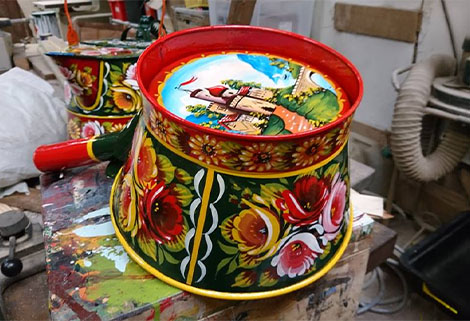
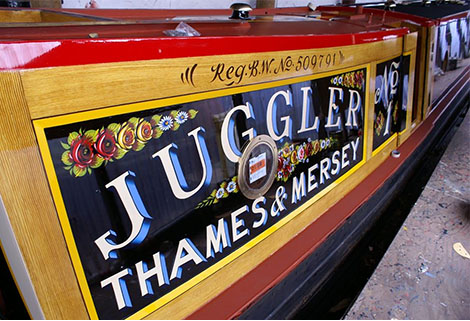
 How to Paint Roses and How to Paint Castles are available for £13.50 each, or £25 for the two.
How to Paint Roses and How to Paint Castles are available for £13.50 each, or £25 for the two. As some of you may know I contracted Leptospirosis in May 2014 and although I didn’t really want to write this article and elicit sympathy from anyone and have avoided writing it for a few years, I felt that now was the time especially with the increase in vessels being converted into houseboats.
As some of you may know I contracted Leptospirosis in May 2014 and although I didn’t really want to write this article and elicit sympathy from anyone and have avoided writing it for a few years, I felt that now was the time especially with the increase in vessels being converted into houseboats. Most people who develop a leptospirosis infection only get mild symptoms but a bit more serious influenza- like symptoms are also quite common. In a minority of infected persons, leptospirosis develops into the dreaded Weill’s disease. Weill’s disease is a serious condition that can involve liver failure, kidney failure, meningitis and sepsis. Weill’s disease can be fatal.
Most people who develop a leptospirosis infection only get mild symptoms but a bit more serious influenza- like symptoms are also quite common. In a minority of infected persons, leptospirosis develops into the dreaded Weill’s disease. Weill’s disease is a serious condition that can involve liver failure, kidney failure, meningitis and sepsis. Weill’s disease can be fatal. When infected blood or urine gets into water or soil, the bacteria can survive there for several months.
When infected blood or urine gets into water or soil, the bacteria can survive there for several months. Anglers and bankside/sewer workers should wear splashproof clothing and expecially gloves. Anglers are at higher risk as it is reasonably common to cause minor cuts with hooks, knives and the like, and this greatly increases the ease by which the bacteria can enter the body. Fish caught from suspect areas should of course never be eaten. Whilst cooking does in theory kill any bacteria within a fish, very often the level of cooking is insufficient to guarantee safety.
Anglers and bankside/sewer workers should wear splashproof clothing and expecially gloves. Anglers are at higher risk as it is reasonably common to cause minor cuts with hooks, knives and the like, and this greatly increases the ease by which the bacteria can enter the body. Fish caught from suspect areas should of course never be eaten. Whilst cooking does in theory kill any bacteria within a fish, very often the level of cooking is insufficient to guarantee safety. Elliott Berry is the owner of Marsurv, Independent Marine Surveyors and Consultants, and is himself an independent Marine Surveyor/Naval Architect & Consultant.
Elliott Berry is the owner of Marsurv, Independent Marine Surveyors and Consultants, and is himself an independent Marine Surveyor/Naval Architect & Consultant.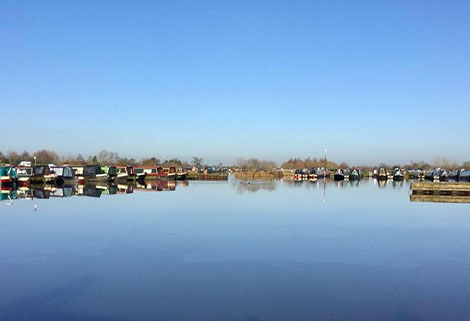

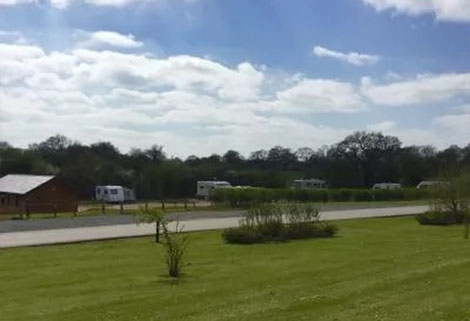


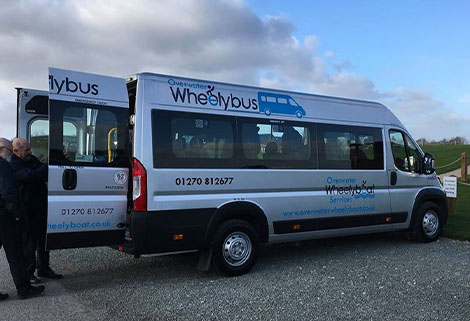
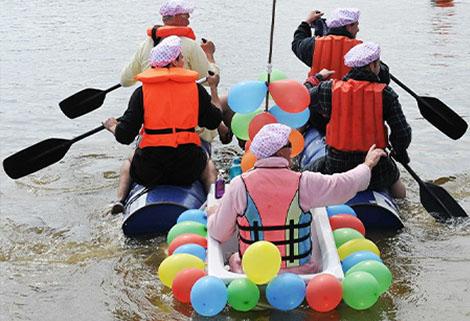
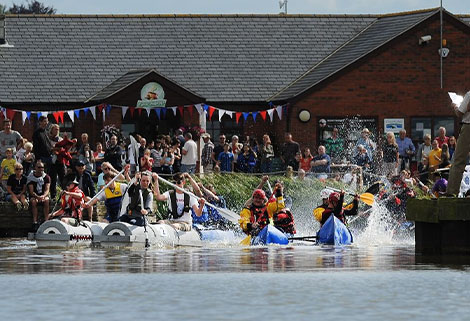
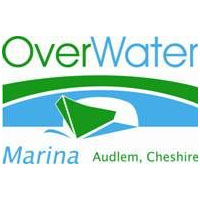 Overwater Marina is an award winning marina set in the Cheshire countryside at Audlem and offers moorings on the Shropshire Union Canal.
Overwater Marina is an award winning marina set in the Cheshire countryside at Audlem and offers moorings on the Shropshire Union Canal.